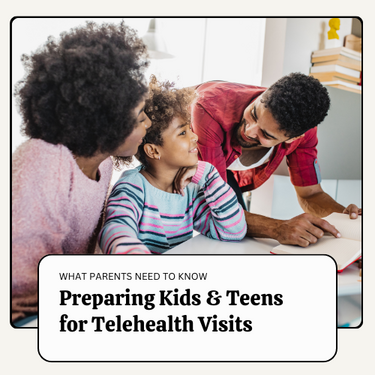
Parents are finding that many therapists, psychologists, psychiatrists, and even pediatricians, OT's and camps, are offering services online. Here is our tips for parents on how to get the best from these online services.
Since the pandemic started, there has definitely been an increase in providers scheduling sessions online so that their clients/patients can continue to access behavioral and physical healthcare and wellness support. This has brought new challenges to not only providers, but also parents and children/teens. However, as we've been learning through these experiences, Telehealth can work just as well, and sometimes even better, for some adults and kids, than an office setting. Some kids have felt overwhelmed and nervous when going to a doctor or therapy office, and parents find they may be more relaxed and easier to engage in a virtual session with their provider when they are comfortably connecting from home.
Here are a few of our tips to help you have a successful Telehealth experience with your child/teen:
Be prepared! Before the session:
Review any instructions shared by the provider and email or call with questions in advance of the scheduled visit to allow the provider time to respond.
Choose a quiet, comfortable, space that minimizes distractions and provides privacy to hold the virtual session.
Gather any supplies requested by the provider and have them available.
Have a notepad and pen available for taking notes and your calendar handy for setting up subsequent appointments if needed.
Set up the device you intend to use and practice. Test everything out prior to the session to make sure it all works and you have time to do any troubleshooting.
Download any apps that are required and give yourself and your child enough time to trouble shoot and get familiar with the program.
Ensure you have the internet speed required, an Ethernet cable or cellular service to connect.
If using your desktop, you may need the latest version of your web browser and there may need a particular platform recommended such as Chrome or Firefox. Close out any unused programs that may be running the background of your device.
Ensure you enable your webcam and microphone and volume is set at an audible level.
Make sure your device is charged and/or your charger is nearby.
Optimize your visibility
Be comfortable but remember that appropriate dress that would be worn to a face-to-face session is required during virtual sessions.
Children may need a workspace, depending on the type of visit. They may also want to have their weighted blanket or stuffed animal nearby and a water bottle. Adults may want to snuggle up with their favorite blanket, a warm cup of tea, tissues, etc.
Make sure your child is hydrated, has eaten something so they are not hungry (or hangry), and has used the bathroom prior to the session.
Join the session a few minutes before your appointment is set to start. You may be taken to a virtual waiting room, much like an in-person session.
During the session:
At the beginning of the meeting, you may be asked to confirm your address/location, and your identity, such as name and date of birth and that of others attending.
For child/teen sessions, many providers will ask parents to join the session together with their child and end the session together. Parents are usually required to be present for all or part of the session depending upon the requirements of the provider and your child’s needs. Even if not in the room during the session, parents will need to be available in person at the meeting location for the duration of the session. Parents must be able to join the session at any time if their child reaches out to them or the provider calls/texts the parent. If the parent cannot be present, they will need to designate another adult and clear that in advance with the provider.
Try to engage as you normally would with your provider. Treat it just like a normal session! Surprisingly, video sessions can feel just as personal as in-person ones.
Troubleshooting:
Despite the best planning, unfortunately, technical issues are inevitable! Talk with the provider about any directives related to connectivity issues at the start of the session. Most of the time, the provider will attempt to refresh and reconnect and/or ask you to do the same. If the ability to reconnect is not possible the provider may use the program’s chat function, or email, call or text you, so you will want to make sure they have the correct contact information on file to reach you if there are problems. You may also want to check your volume, see if your video, microphone and video camera are on, and you are connected to the internet.
After the Session:
Disconnect from the session and close out the program.
Review your notes to make sure you captured all the information you need.
Schedule any follow ups with the provider or referrals.

Sign up for our newsletter to get instant access to parenting resources sent directly in your inbox!
